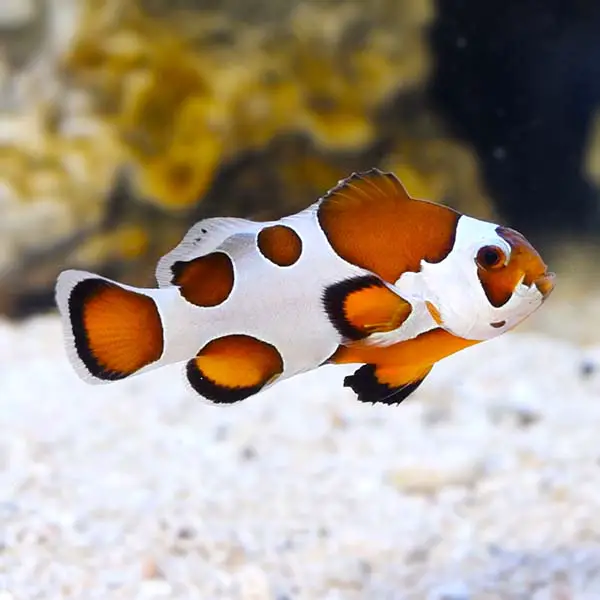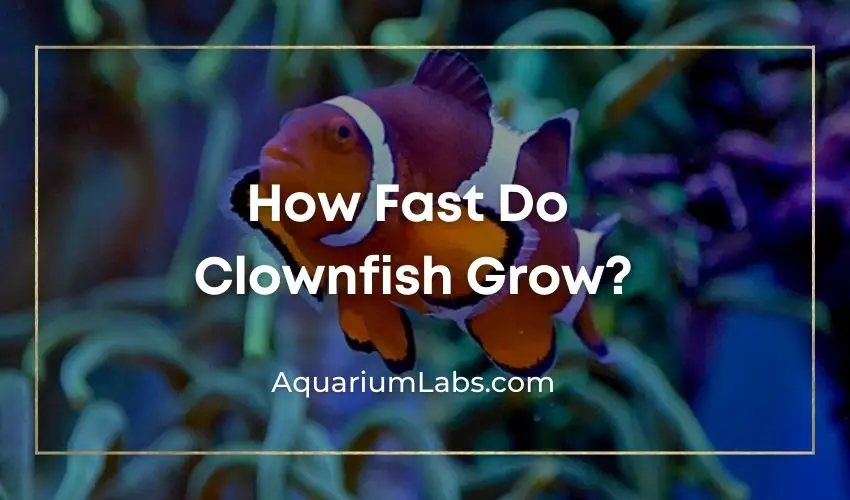Introduction
Not everyone would like to buy a matured clownfish. It is often more enjoyable to witness a clownfish reach maturity from babyhood. But the challenge of going through this route is the uncertainty about the eventual size.
Exactly how fast do clownfish grow? Clownfish may live for a long time if given proper care. It is not unusual for these species to live to be twenty years old.
A species that stays for about twenty years does not become too large too quickly. That’s nature’s working principles. Now, how fast do they grow?
Is there anything you can do to help clownfish grow? Does this process have a cost undertone? We’ll go over everything regarding the rate of growth of a typical clownfish and more vital information in this article.
Clownfish: Growth Rate Vs. Species
The rate at which clownfish grow varies depending on the species.
We’ve answered the “how fast do clownfish grow” question below to help you see how quickly each variety grows to let you know the distinction.
Ocellaris Clownfish

Ocellaris Clownfish is the most widely accessible of the thirty clownfish species. This is why they are known as Common Clownfish.
These marine creatures are simple to care for and grow. Typically, Ocellaris tend to grow between three to four inches tall. But some other Ocellaris Clownfish can reach 4.3 inches.
They will grow approximately half an inch during their first year. The next year, they will reach a height of one inch.
Tomato Clownfish
The Tomato Clownfish is a Western Pacific native. These species are bigger than Ocellaris, the Common Clownfish.
Although this sea creature appears to be a sweet little animal, it could be violent at times. They have a long white stripe around their heads and are generally orange-colored.
Tomato Clownfish can reach 5-5.5 inches in length and increase by one inch every year.
Cinnamon Clownfish

Although the Cinnamon Clownfish is part of the tomato complex, its development rate is distinct.
The body of this fish is generally dark orange with shades of mahogany by its sides.
Cinnamon Clownfish grow to reach 4.7 inches. Their annual rate of growth is upwards of one inch.
Clarkii Clownfish
Clarkii Clownfish are one of the smallest, although they are quite beautiful.
The Pacific Ocean is home to this species of fish. They’ve got black and white stripes with a brilliant yellow body.
Clarkii fish may reach a length of four inches and typically increase half an inch per year.
Darwin Clownfish
The Darwin Clownfish is among the varieties of the Ocellaris Clownfish.
It has markings that are comparable to that of Common Clownfish. Their hue, though, is white with black stripes. They are the tiniest, at about three inches long.
Darwin Clownfish grow half an inch to an inch every year. They take two to three years to completely grow.
Maroon Clownfish
It is now time to meet the biggest of all the different clownfish.
The largest and most violent clownfish is none other than the Maroon Clownfish. It may grow up to seven inches long and has a deep maroon coloration with straight white lines.
Maroon Clownfish typically grow one inch every year and require between six to seven years to reach full maturity.
Frostbite Clownfish
Snowflake and Wyoming White Clownfish were crossed to produce this type of clownfish.
While they can grow to be approximately four inches in length, the majority of them are just three inches.
Like Percula and Ocellaris Clownfish, these fish increase at a pace of 0.5 – 1 inch every year.
As a result, they require about three years to reach their maximum size. Their usual buying size is between half to one inch.
Black Clownfish

Black Clownfish are part of the Percula species. As a result, their highest size and development rate are equal to those of false Percula Clownfish.
In adulthood, these fish reach a length of roughly three inches, growing at a pace of 0.5–1 inch each year. As a result, it takes those around three years to reach their maximum size.
Pink Skunk Clownfish
Do not judge a book by its cover. These clownfish species are by far the most violent of the bunch.
Yearly, they grow four inches at a pace of 0.5 – 1 inch. As a result, they might take between three to five years to achieve their size limit.
The estimated purchasing size of a Pink Skunk Clownfish is between ¾ – 1-¼ inches.
Orange Storm Clownfish

The Orange Storm Clownfish is as beautiful as its names suggest.
They are small, only reaching a maximum size of 3 inches. These species have a growth pace of about 0.5 – 1 inch per year, taking around three years to attain full size, just like their other clownfish cousins.
The usual purchasing size of this type of clownfish is between 1 – 2 inches.
Clownfish Fry
The eggs of Clownfish Fry are spherical and measure between four to six millimeters.
It takes between six to seven days for the eggs to hatch. Feeding Clownfish Fry will have metamorphosis occurs on the tenth day; thus, hatching fish need around ten days to transition from the larval stage to juveniles.
Clownfish Fry grows about four to six inches in one or two years.
Related Reading:
Relationship Between Clownfish’s Growth Rate And Their Sexes
Of course, size is important when you are a clownfish. Clownfish thrive in pairs of two or three . The female is always the largest part of the pair.
She is a dominant female. And she’s at the top of the rank, and she’s always given the greater portion of the resources to keep her hefty body.
The mating male is the second largest fish after that. And unsurprisingly, he is ranked second. As a result, the ranking order is determined by the magnitude of the fish.
Furthermore, researchers have discovered that when the hierarchy drops, there’s a mean size differential of about ten millimeters.
Species, Growth Rate, and Average Size: How They Compare
| Species | Growth Rate per Year (Inches) | Average Size (Inches) |
|---|---|---|
| Percula Clownfish | 0.5-1 | 3 |
| Saddleback Clownfish | 1 | 4.7 |
| Tomato Clownfish | 1 | 5-6 |
| Maroon Clownfish | 1 | 5-6 |
| Frostbite Clownfish | 0.5-1 | 3 |
| Darwin Clownfish | 0.5-1 | 3 |
| Cinnamon Clownfish | 1 | 4.7 |
| Black Clownfish | 0.5-1 | 3 |
| Clarkii Clownfish | 0.5-1 | 6 |
| Pink Skunk Clownfish | 0.5-1 | 4 |
| Orange Storm Clownfish | 0.5-1 | 3 |
| Ocellaris Clownfish | 0.5-1 | 3-3.5 |
Helping Clownfish Grow Quickly
So far as you feed most clownfish the correct foods, they will grow quickly. Here are a few tips to ensure that your clownfish grow quickly and healthily.
Feed Your Clownfish Twice a Day
Feed them at least two times every day. Occasionally, it is good to give them special delicacies.
Use of Clean Tanks
Don’t keep the tank dirty for lengthy periods of time as this might cause their illnesses, especially for clownfish growing in disease-prone environments to get a healthy fish.
Keep An Eye Out For Diseases
Take your fish to the doctor if you see any skin patches or grill and fin rots.
Such conditions might impede their growth rate. The fact is that none of these tricks will make your clownfish grow. A clownfish increases by around 1 inch every year.
However, supplying them with essentials can boost their health.
Clownfish Thrive in a Stress-Free Setting
Clownfish, all thirty types of them, are territorial creatures.
You must make certain that each fish has enough space to establish his area, that the aquarium is free of dangers, and that there are enough resources and hiding sites.
As with all fish, Clownfish release a larger quantity of the hormone cortisol when they are stressed. This hormone suppresses a fish’s desire for food while also weakening its innate immunity.
Constant Water Changes
According to many studies, fish send certain secretions into their environment that has been proven to limit how much the other fishes in the area grow.
These secretions, known as pheromones, would not have been a significant issue in a saltwater fish because of the larger body of water where they would be quickly washed away and diluted.
However, in confined systems such as aquariums, they have nowhere to go but to be incorporated into the body of the fish.
To eliminate these pheromones, it is necessary to do regular water changes.
The Role Of A Well-Balanced Diet
There are no hard and fast rules when it comes to these fishes or some other fishes.
Some enthusiasts feed two times every day, while others would stick to just feeding once per 48 hours. Everything comes down to the clownfish’s requirements and your comfort.
Regardless of the amount or the frequency with which you feed them, the most essential thing is to give them well-balanced food that’s enriched with all of the essential nutrients they require. Clownfish eat everything.
As a result, feeding them is a breeze. You’ve got several alternatives available to you. Make a conscious effort to give them a high-protein live and frozen food several times weekly to provide them with a diverse yet balanced diet.
The Role Of A Get A Bigger Tank
Most clownfish only reach 3 inches in length, while others reach six inches. As a result, the suggested minimum tank capacity ranges from twenty to seventy gallons.
Although it is a fallacy that fish adapt to small tanks, a tiny container can certainly limit their growth. It does it in a variety of ways.
Firstly, the growth-stunting pheromones aren’t rinsed away or weakened enough to be harmless.
Secondly, denying a fish the opportunity to tread the water to its heart’s desire results in a dearth of activity and an elevated risk of muscular atrophy.
Clownfish Lack of Growth: What Causes It?
An adult clownfish may not be increasing in length for a variety of factors.
The difference in the size of certain small clownfish might be hard to discern. One other consideration is feeding because it helps clownfish reach maturity faster.
Do Clownfish Couple Better?
Adult and baby clownfish could be raised in pairs or as solitary fish. It’s much more typical to store them in couples, though.
They are better at ease in groups, and their behavioral patterns indicate that they dislike being the sole clown inside the water.
Conclusion
Knowing what to anticipate before getting a clownfish is safer and better.
It wouldn’t be any more difficult to care for them after reading this post. Don’t get discouraged if your clownfish takes a long time to grow. It will develop to its full size and thrive well.

